Overview
We recognize the critical role that open-source Enterprise Service Bus (ESB) solutions play in modern integration. These solutions are not merely tools; they are essential enablers that enhance connectivity and operational efficiency across various sectors, particularly in banking and healthcare. By providing flexible, reliable, and user-friendly integration tools, we empower enterprises to meet their evolving needs effectively.
What challenges are holding your team back from achieving seamless integration? With the right ESB solutions, we can help you overcome these hurdles and drive your organization forward.
Introduction
In today’s rapidly evolving landscape of digital transformation, we recognize that organizations increasingly turn to open-source integration solutions to bridge the gap between legacy systems and modern applications.
With a plethora of options available, platforms like:
- Avato
- Apache Camel
- Talend Open Studio for ESB
stand out for their unique capabilities and robust features. These tools not only facilitate seamless data exchange but also enhance operational efficiency across various sectors, including banking and healthcare.
As we strive for agility and responsiveness, understanding the strengths of each integration solution becomes essential for achieving our strategic goals and maintaining a competitive edge.
This article delves into the key players in the open-source ESB integration arena, exploring their functionalities, real-world applications, and the transformative impact they can have on organizations like yours seeking to modernize their integration strategies.
Avato: Leading the Charge in Open Source ESB Integration
We distinguish ourselves in the open source ESB connectivity landscape with our hybrid solution, which is designed to effortlessly connect isolated legacy systems and fragmented data. Our platform boasts a robust technological foundation that supports 12 levels of interface maturity, enabling businesses to efficiently balance speed and sophistication in their development projects. This capability is particularly crucial in sectors like banking and healthcare, where secure and dependable connections are essential. Our unwavering dedication to minimizing downtime and ensuring 24/7 availability for critical connections positions us as the preferred solution for organizations eager to innovate without compromise.
Since our inception in 2010, we have successfully implemented hybrid connectivity solutions across various financial institutions, showcasing our ability to manage complex interactions and transformations. A notable example is our partnership with Coast Capital, where our solution went live in February 2013, supporting multiple interfaces and facilitating significant system transitions with minimal downtime. In June 2016, we enabled the transition of Coast Capital’s complete telephone banking and contact center telephony system with just a 63-second disruption, underscoring our proficiency in delivering reliable connectivity.
As the global system unification market is projected to reach USD 528.2 billion by 2025, our strategic focus on enhancing IT infrastructure and eliminating inconsistencies aligns perfectly with industry needs. Furthermore, the hybrid combination market is characterized by low concentration, indicating a fragmented competitive landscape that IT managers must navigate. Our hybrid unification platform not only empowers businesses to future-proof their operations through seamless information and system connectivity but also transforms financial institutions by reducing costs, accelerating product delivery, and enhancing customer satisfaction.
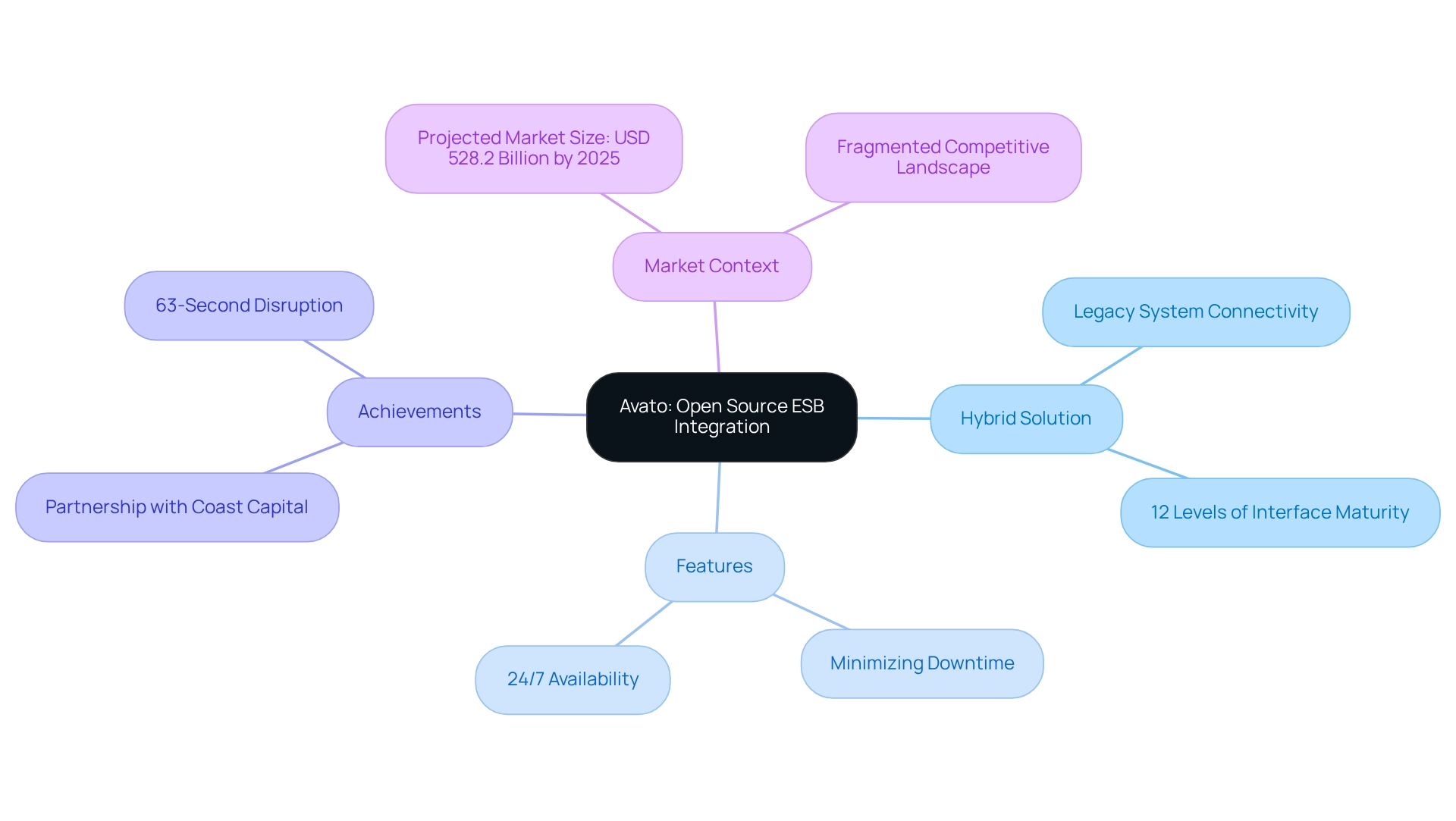
Apache Camel: Versatile Integration Framework for Open Source ESB
Apache Camel serves as a powerful open source ESB framework designed to facilitate seamless information exchange across diverse systems. Its extensive support for various protocols and data formats positions us as a highly adaptable solution for organizations looking to implement service-oriented architectures (SOA). With a rule-based routing and mediation engine, we empower developers to create routing rules through a variety of patterns, thereby significantly simplifying the connection process.
Our framework boasts a comprehensive library of components, enhancing usability for both straightforward and intricate implementation tasks. As we move into 2025, Apache Camel continues to gain traction, with usage statistics reflecting a growing preference among enterprises for its capabilities in managing complex connections effectively. Notably, Avato’s Hybrid Connection Platform bolsters Apache Camel by ensuring 24/7 uptime for critical connections and providing real-time monitoring and alerts. This underscores the reliability and proactive management that connection frameworks can deliver, particularly in sectors such as banking, healthcare, and government.
Experts highlight the advantages of Apache Camel as an open source ESB in SOA, noting its ability to simplify connectivity while maintaining high performance and reliability. Claus Ibsen, a leading expert in the field, underscores the importance of clarity in code, stating, “Hello ${header.name} thanks for ordering ${body}.” This clarity not only enhances the unification process but also simplifies management and troubleshooting. Real-world examples illustrate its effectiveness in banking, where organizations have successfully leveraged Camel alongside alternative solutions to improve operational efficiency and reduce costs. For instance, Gustavo Estrada from BC Provincial Health Services Authority shared his positive experience with the system, emphasizing its capacity to meet unification objectives within financial and time constraints. As companies increasingly prioritize agility and responsiveness, Apache Camel, combined with Avato’s secure hybrid solution, emerges as a flexible choice for contemporary connectivity needs.
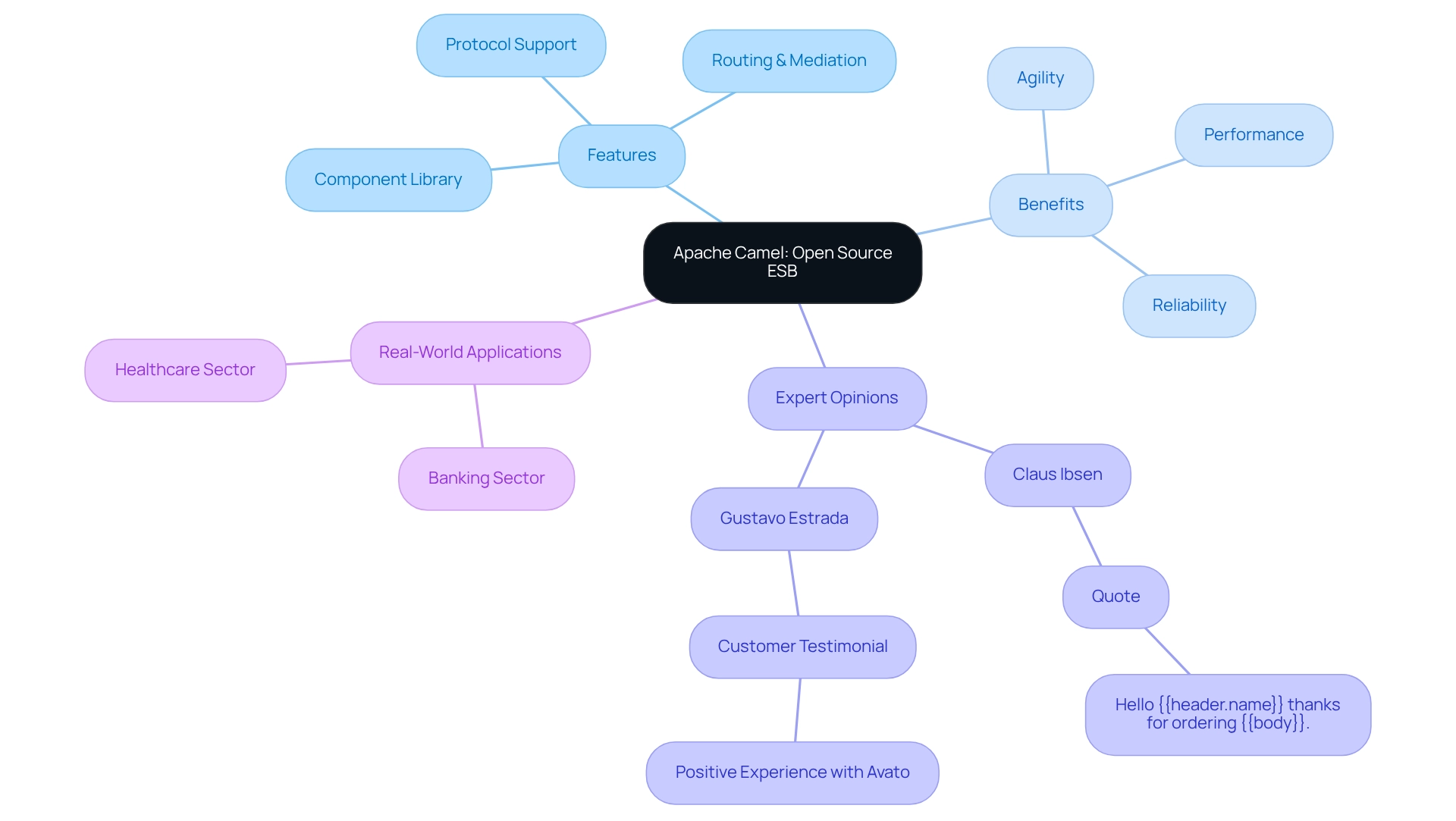
Talend Open Studio for ESB: User-Friendly Open Source Integration Tool
Talend Open Studio for ESB is a powerful open source esb tool that distinguishes itself in the integration landscape. With its intuitive drag-and-drop interface, we simplify the creation and management of workflow processes, allowing our users to connect applications and services effortlessly. Our platform supports a diverse array of data sources and formats, ensuring seamless integrations. The extensive community support and comprehensive documentation we provide empower users to adopt best practices and enhance their connection processes effectively. As we look to 2025, we see adoption rates for Talend Open Studio for open source esb surging, reflecting its growing popularity among enterprises seeking user-friendly solutions. Recent updates have further improved its functionality, enabling both novice and experienced users to tackle complex connection scenarios with ease. Notably, user satisfaction data reveal a high degree of happiness among our users, underscoring the tool’s efficiency in meeting various unification needs.
At Talend Academy, we play an essential role in helping users recognize learning pathways, ensuring swift adaptation to operational effectiveness—crucial for organizations aiming to update their unification strategies. Real-world instances, particularly in the healthcare sector, showcase our ability to facilitate secure and trustworthy connections. For instance, the BC Provincial Health Services Authority commended us for simplifying consolidation processes, illustrating our value in settings where information security is paramount. Furthermore, industry leaders emphasize the importance of community backing in open-source tools, reinforcing our status as a frontrunner in this area. As Cassie Kozyrkov has pointed out, identifying pertinent use cases is key to maximizing the potential of connection tools. By supporting multiple information sources and providing an intuitive interface, Talend Open Studio for open source esb continues to be a favored option for businesses looking to enhance their connectivity strategies in 2025. Moreover, utilizing XSLT for effective XML information transformation within Avato’s hybrid system not only improves operational capabilities but also significantly reduces programming errors and costs associated with information management. This strategic approach positions Avato as a committed hybrid solution, streamlining disparate systems and enhancing business value, ultimately transforming B2B customer experiences by bridging legacy systems with modern expectations.
WSO2 ESB: Comprehensive Open Source Integration Solution
At WSO2, we recognize that effective API management is crucial for modern enterprises. WSO2 ESB stands out as a powerful open source ESB solution, providing a comprehensive suite of features tailored for managing APIs, services, and data flows. Its lightweight architecture facilitates seamless deployment in cloud-native and container-native environments, making it particularly suitable for contemporary enterprises. By supporting a range of connection patterns and protocols, we guarantee seamless communication among various systems.
Our system’s built-in monitoring and analytics features provide organizations with essential insights into their connection processes, greatly improving operational efficiency. Significantly, we ensure round-the-clock availability for essential connections, meeting the urgent demand for dependability in today’s dynamic business environment. Our hybrid platform is focused on streamlining intricate connections, allowing companies to enhance the worth of their legacy systems while substantially lowering expenses. Recent market adoption statistics show an increasing preference for open source ESB solutions among organizations seeking efficient API management. Industry specialists, including Hilary Mason, have underscored the significance of monitoring in unified solutions, stressing how data analytics can enhance organizations and society as a whole. This aligns perfectly with our capabilities in providing operational excellence, as real-world examples from the banking sector illustrate how the open source ESB from WSO2 has successfully streamlined API management, resulting in improved service delivery and customer satisfaction. Moreover, customer feedback, such as that from Gustavo Estrada, commends us for our capacity to match desired results with time limits and budget constraints, further emphasizing the efficiency of our unification solutions.
As organizations progressively acknowledge the significance of oversight in unification solutions, our features in this domain are emerging as a crucial differentiator. We not only facilitate operational excellence but also enable businesses to utilize cloud-native connection solutions effectively, ensuring they stay competitive in their respective markets. Let us partner with you to elevate your API management strategy and drive your business forward.
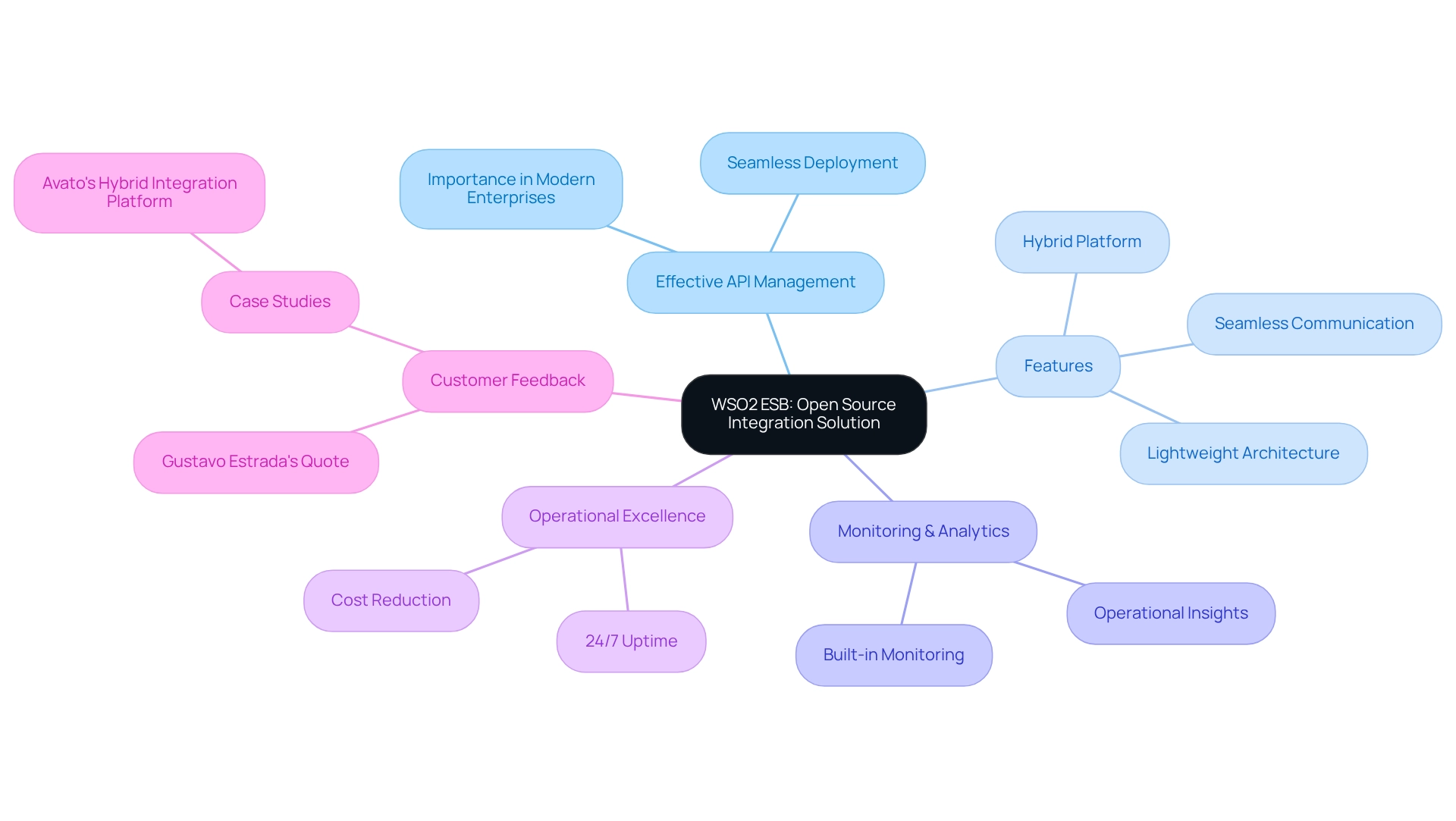
MuleSoft Anypoint Platform: Powerful Integration Capabilities with Open Source Elements
We recognize that in today’s fast-paced digital landscape, a robust unification solution is essential. MuleSoft Anypoint Platform stands out as a powerful tool that seamlessly merges proprietary features with the flexibility of open-source elements. This system empowers us to create, launch, and oversee APIs and connections from a centralized interface, streamlining our connectivity environment significantly. With a vast collection of connectors and pre-designed templates, we accelerate the unification process, enabling businesses to swiftly link various applications and data sources.
Furthermore, our sophisticated monitoring and management tools enhance functionality, making MuleSoft an ideal choice for enterprises aiming to optimize their unification strategies. Insights from the 2025 Connectivity Benchmark Report reveal that cohesive unification strategies are pivotal for organizations seeking transformative success. As Beena Ammanath, Global AI Institute Leader, states, “To maximize the benefits of AI and digital agents, organizations should create a proactive unification strategy that brings together the entire IT estate.” This highlights the critical need for integrating systems to fully leverage the potential of AI and digital agents.
In addition, MuleSoft’s connection success rates are bolstered by our ability to adapt to the evolving demands of enterprises, particularly in the financial services sector. Real-world examples illustrate how organizations leveraging MuleSoft have achieved enhanced agility and efficiency, positioning themselves competitively in a rapidly changing market. Moreover, our dedicated hybrid unification system ensures 24/7 availability for essential connections, showcasing its reliability in delivering outcomes by accessing isolated resources. As the integration landscape continues to evolve, we affirm that both MuleSoft Anypoint Platform and expertise in hybrid connectivity are indispensable tools for enterprises seeking to streamline operations and enhance connectivity capabilities.
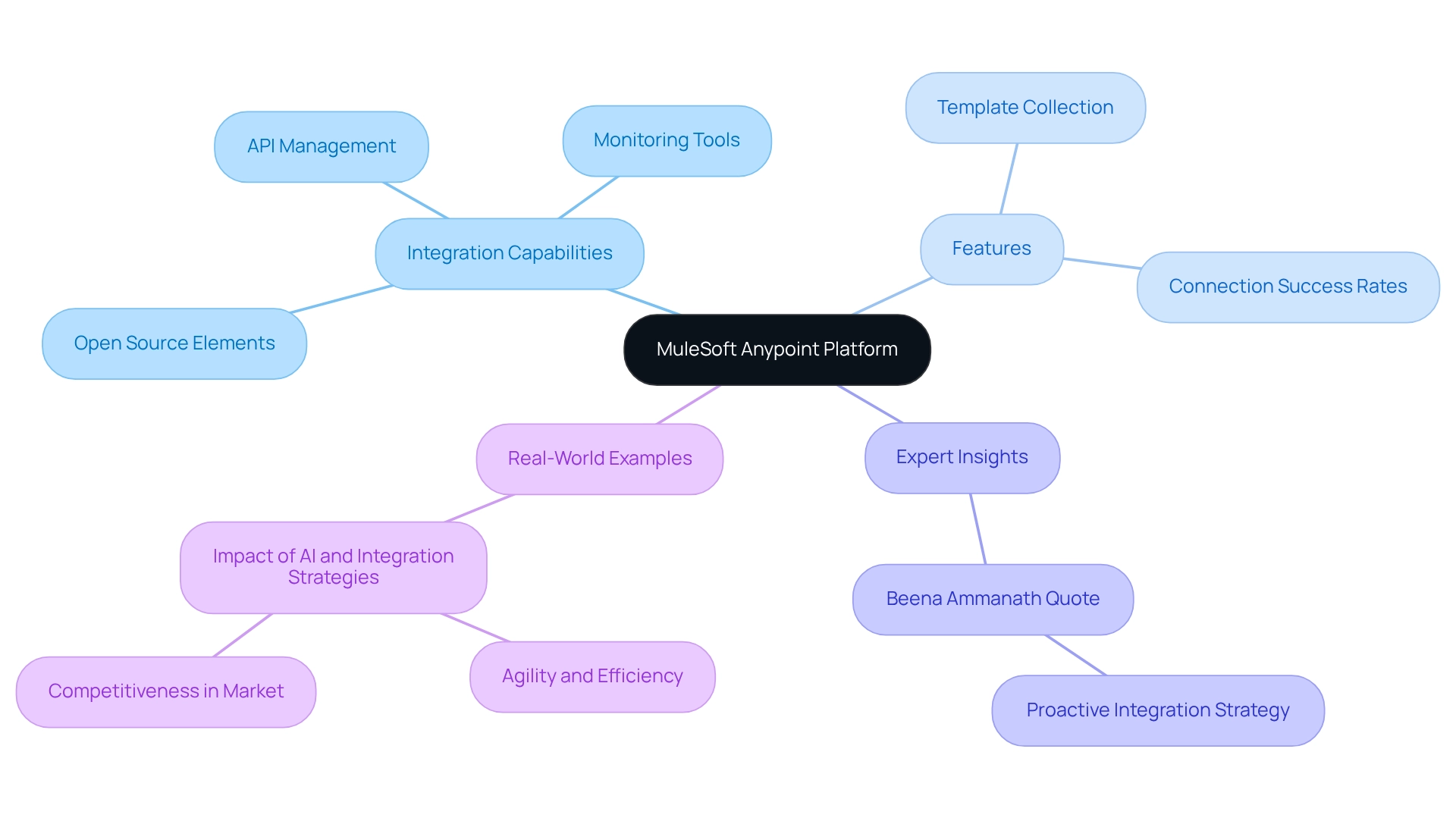
Red Hat Fuse: Scalable Open Source Integration with Apache Camel
We aim to revolutionize secure system connectivity across critical sectors, including banking, healthcare, and government. Our hybrid platform leverages the power of XSLT to facilitate efficient XML information transformation, significantly reducing errors and enhancing information management processes.
With a robust architecture, we ensure the seamless unification of isolated systems and fragmented data, providing the connected foundation essential for businesses to modernize their operations.
What challenges are you facing in achieving this connectivity? Testimonials from esteemed clients, such as Tony LeBlanc from the Provincial Health Services Authority, highlight our professionalism and expertise, solidifying our reputation as a trusted partner in digital transformation initiatives.
By integrating continuous monitoring and analytics, we guarantee optimal performance, empowering organizations to balance speed and sophistication in their technology stack.
Are you ready to elevate your operations with our solutions?
Apache Kafka: Essential Streaming Platform for Modern Integration
Apache Kafka stands as a robust distributed streaming platform, expertly designed to manage real-time information feeds with efficacy. Our framework empowers the construction of information pipelines and streaming applications, making it indispensable for tackling modern integration challenges. With the capability to handle extensive volumes of information with minimal latency, we enable organizations to swiftly adapt to evolving business requirements. Its fault-tolerant architecture and scalability are particularly advantageous for enterprises seeking to implement event-driven architectures and leverage real-time analytics.
In 2025, we have witnessed a significant surge in the adoption of Apache Kafka among enterprises, reflecting a growing acknowledgment of its pivotal role in enhancing operational efficiency and responsiveness. Industry leaders emphasize that low latency in information processing is crucial for maintaining a competitive edge, further underscoring Kafka’s importance in today’s information landscape. Real-world examples illustrate how organizations in finance have effectively utilized Kafka for real-time data unification, showcasing its efficiency in building robust data pipelines that support dynamic business environments.
Moreover, our commitment to providing a reliable technology stack aligns seamlessly with Kafka’s capabilities, ensuring businesses can modernize their operations effectively. Avato’s hybrid unification platform has proven transformative for financial institutions, facilitating cost reduction, faster product delivery, and improved customer satisfaction. As Tim O’Reilly aptly states, ‘We’re entering a new world in which information may be more important than software,’ highlighting the essential role of information in the current unification landscape. Furthermore, with the demand for information specialists rising at a staggering rate of 36%, the importance of information unification solutions like Kafka is clearer than ever. Insights from Hilary Mason further emphasize that analytics and science revolve around curiosity and understanding patterns, illustrating the societal benefits of effective real-time processing. What’s holding your team back from harnessing these capabilities?

Cleo Integration Cloud: Secure and Efficient Data Integration
At Cleo, we recognize that the landscape of cloud integration is evolving, and security is paramount. Cleo Integration Cloud stands as an advanced cloud-based solution that excels in enabling secure and efficient information integration across various applications and services. With a strong emphasis on security, we incorporate advanced features such as encryption and stringent access controls, ensuring that sensitive data remains protected during transmission. In a landscape where 72% of companies express concerns about cloud security, our robust measures are essential for mitigating risks associated with insecure interfaces—identified as a significant threat by 52% of organizations in public cloud environments. This highlights the critical need for platforms like ours that prioritize security.
As financial institutions prepare for open banking, leveraging existing systems while ensuring compliance with stringent security protocols is crucial. Cleo Integration Cloud embodies this principle, providing an intuitive interface alongside robust automation features that simplify the linking process. This efficiency is especially advantageous in sectors such as banking, where secure information exchange is essential. Practical instances illustrate our efficiency in B2B connectivity, showcasing how businesses can enhance operational capabilities while upholding strict security standards.
Furthermore, as companies increasingly depend on cloud solutions, understanding the shared responsibility model becomes essential for protecting sensitive information. Cleo Integration Cloud exemplifies best practices in security, as illustrated in our case study titled ‘Safeguarding Cloud Security.’ This case study emphasizes measures such as multifactor authentication and access controls. For banking IT managers, evaluating Cleo Integration Cloud for their connectivity requirements is crucial, as we not only address security issues but also empower businesses to safeguard their operations through seamless information and system connections.
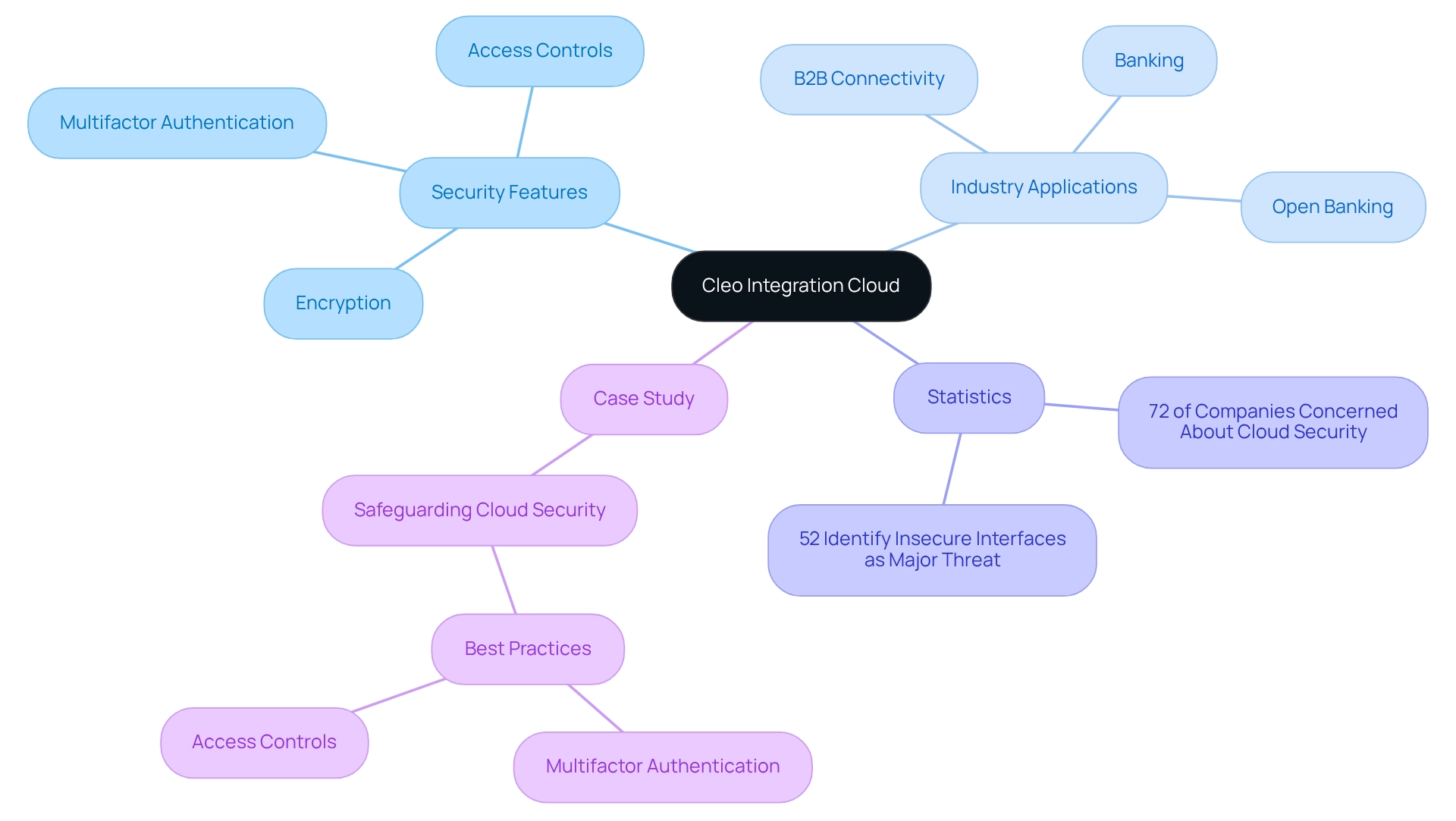
SnapLogic: Cloud-Based Integration Supporting Open Source ESB
We have developed an advanced hybrid connection platform that enables seamless links between applications, data, and services. This initiative stems from our commitment to resolving complex unification challenges, empowering organizations to effectively connect previously disjointed systems. In sectors like banking, where reliability is paramount, we ensure 24/7 uptime for essential systems—a crucial aspect for IT managers focused on system reliability and operational continuity.
Our platform’s support for open source ESB functionalities enhances its adaptability, making it an ideal choice for enterprises pursuing hybrid unification strategies. Key features include:
- Automated process management
- Real-time data synchronization
- Robust security protocols
All designed to simplify disparate systems and boost operational efficiency. By leveraging our platform, organizations can significantly enhance their collaboration efforts, ensuring competitiveness in an increasingly cloud-focused environment.
Statistics indicate that we maintain a high success rate for assimilation projects, with numerous organizations reporting improved operational efficiency and reduced technical debt. Transformative case studies, such as our work with Coast Capital, demonstrate how financial sector companies have successfully embraced our solution to streamline processes, resulting in enhanced data accessibility and faster decision-making.
As automation continues to play a pivotal role in unification, industry leaders stress the importance of platforms like ours that prioritize ease of use and scalability. Jeremiah Stone, the Chief Technology Officer of SnapLogic, wisely suggests that leaders ought to focus on initiatives that minimize technical debt, generate new sources of revenue, or make technologies more accessible. By investing in such technologies, organizations not only enhance their connectivity capabilities but also position themselves for future growth and innovation. Furthermore, we emphasize the necessity of investing in training, communication, and implementation plans to effectively harness AI, ensuring that organizations maximize the benefits of their strategies.
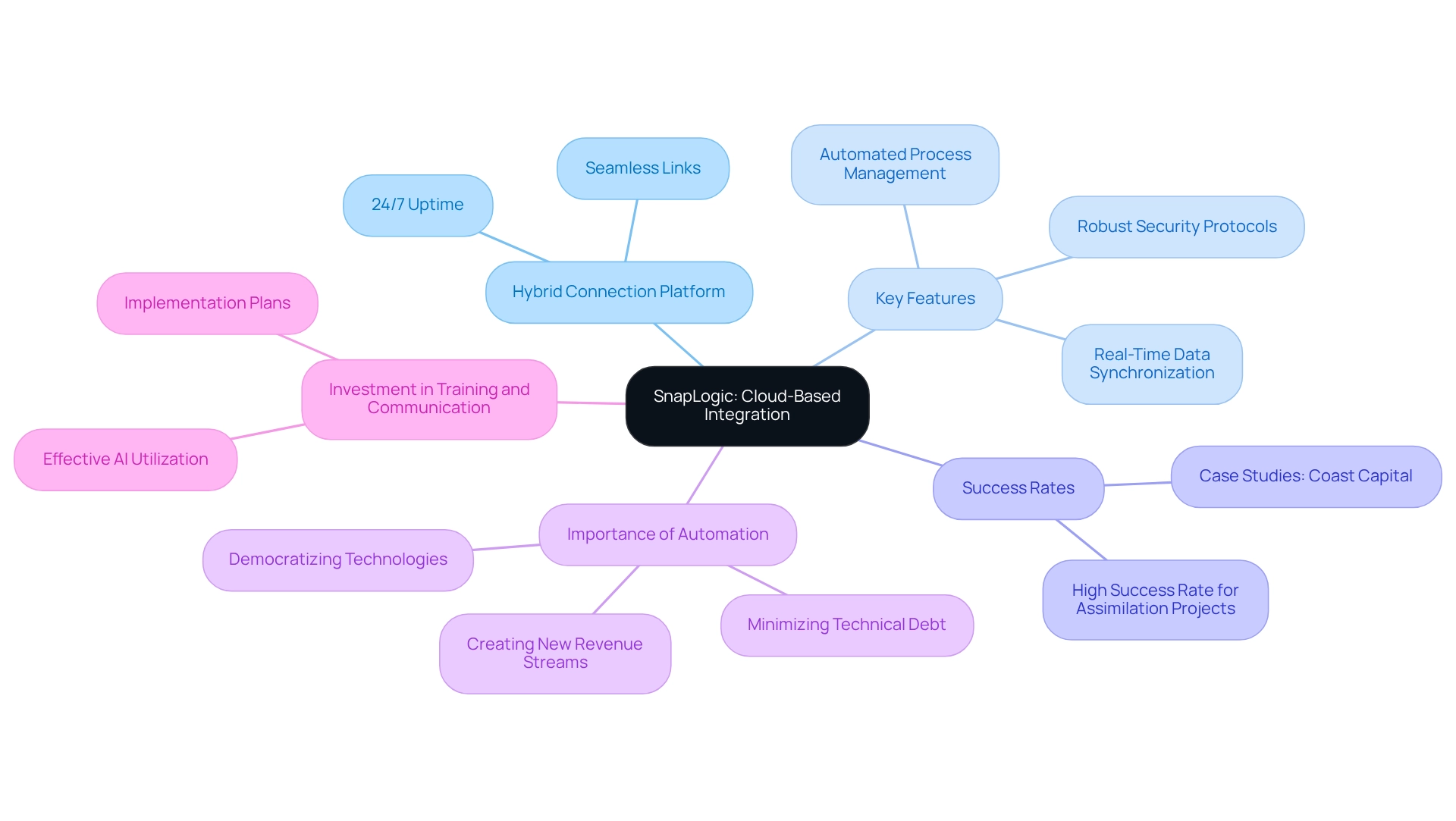
Jitterbit: API Management and Open Source Integration Combined
At Jitterbit, we stand out as a formidable merging solution, seamlessly integrating powerful API management features with open source ESB connectivity functionalities. We empower organizations to create, manage, and secure APIs using an open source ESB while effortlessly connecting various applications and information sources. Our user-friendly interface and low-code development environment enable swift implementation of workflow processes, catering to users across a spectrum of technical skill levels. By focusing on automation and real-time data processing, we simplify operations and enhance decision-making processes, making Jitterbit an attractive choice for enterprises aiming to elevate their unification strategies.
Recent trends indicate a growing reliance on Jitterbit for API management, particularly in sectors such as financial services, where connection complexities abound. Case studies demonstrate that organizations leveraging Jitterbit have achieved remarkable improvements in operational efficiency and user satisfaction. As Selvaratnam Uthaiyashankar, a senior vice president at WSO2, notes, “AI-powered connections are facilitating a robust new generation of intelligent applications and digital services, yet they also introduce new layers of complexity.” This underscores the pressing need for solutions like Jitterbit that simplify these challenges.
Furthermore, our unwavering commitment to ensuring 24/7 uptime for critical connections highlights the reliability essential for banking IT managers when assessing platform options. We expedite the integration of separate systems and scattered data, delivering the unified framework that businesses need to streamline, standardize, and update. Designed for secure transactions, Avato is trusted by banks, healthcare, and government, positioning us as a key player in the evolving landscape of integration technologies.
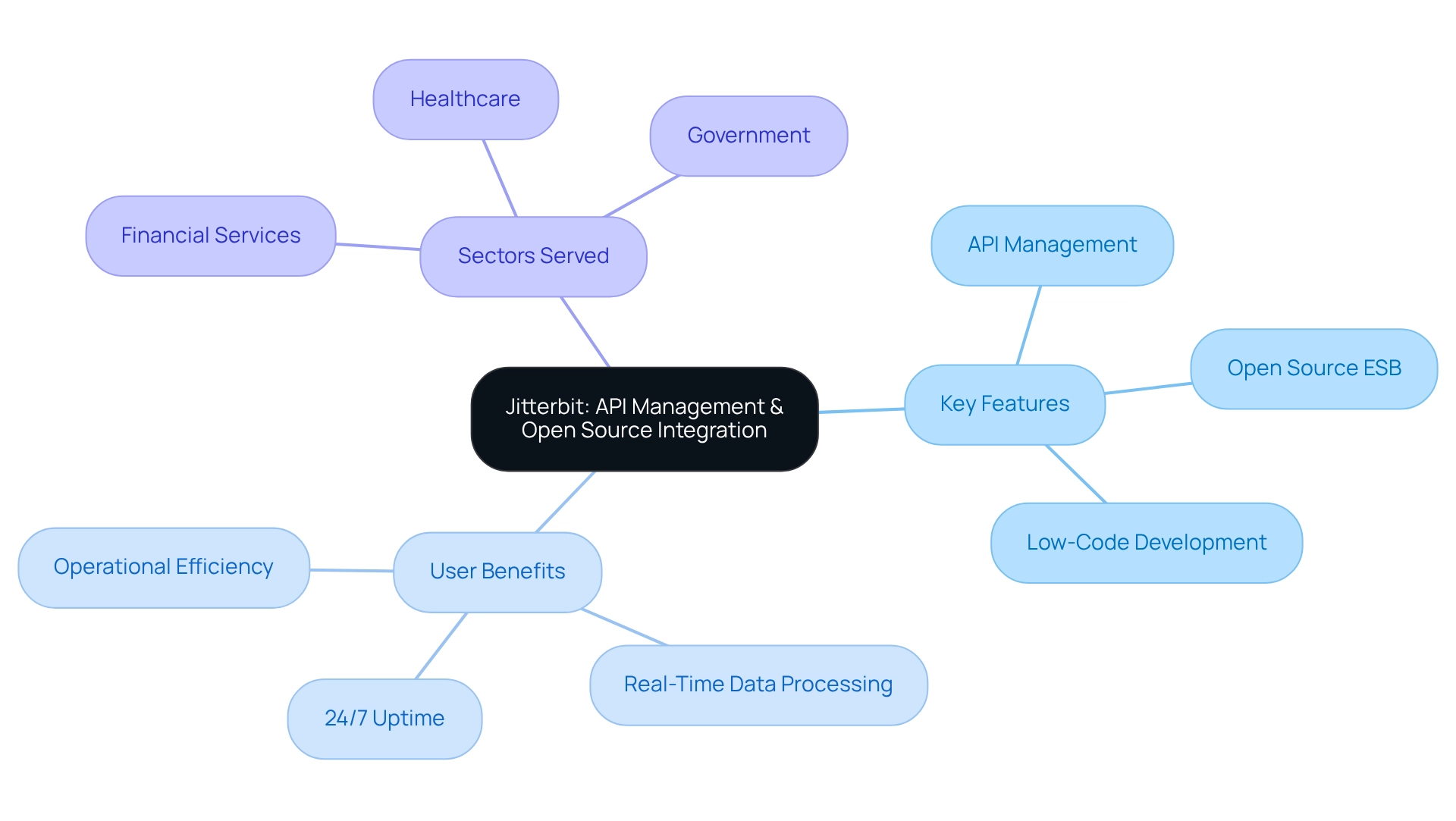
Conclusion
In today’s digital transformation landscape, we recognize that open-source integration solutions are essential for organizations aiming to modernize their integration strategies. Key platforms such as Avato, Apache Camel, and Talend Open Studio for ESB facilitate seamless connectivity between legacy systems and modern applications.
Avato excels with its hybrid integration capabilities and unwavering commitment to 24/7 uptime, making it particularly valuable for sectors like banking and healthcare. Apache Camel offers versatility through its robust framework, simplifying the implementation of service-oriented architectures. Talend Open Studio for ESB is renowned for its user-friendly interface and strong community support, empowering users to tackle integration tasks effectively.
Furthermore, WSO2 ESB and MuleSoft Anypoint Platform enhance integration capabilities even further. WSO2 emphasizes API management and real-time analytics, while MuleSoft combines proprietary features with open-source flexibility for streamlined application connections. Additionally, platforms like Cleo Integration Cloud and Jitterbit prioritize security and automation, addressing critical data protection needs in cloud environments.
As we prioritize agility and responsiveness, understanding the strengths of these integration solutions becomes crucial for maintaining a competitive edge. By leveraging these platforms, we enable businesses to enhance operational efficiency, reduce costs, and improve customer satisfaction. Ultimately, adopting open-source integration tools is not merely a strategic choice; it is a vital step toward achieving sustainable growth in today’s interconnected digital world.

